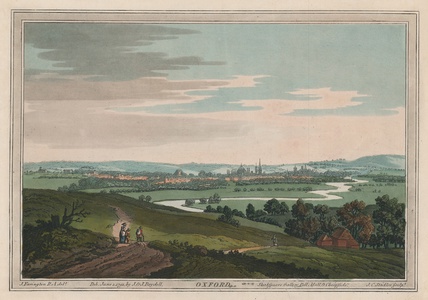| Method | Aquatint with original hand colouring |
| Artist | Joseph Constantine Stadler after Joseph Farington |
| Published | Pub. June 1, 1793, by J. & J. Boydell. Shakspeare Gallery, Pall Mall & Cheapside. |
| Dimensions | Image 201 x 304 mm, Sheet 285 x 385 mm |
| Notes |
A view of Oxford from A History of the River Thames published by John and Joshia Boydell in 1793-1796. The brothers originally intended to include the rivers Thames, Severn, Forth and Clyde 'and intended to illustrate an original History of those Rivers, including all that adorns, dignifies or enriches them and their Vicinities, whether of Art or Nature'. The project was abandoned at the completion of the History of the Thames Joseph Constantine Stadler was a printmaker of German origins, working in London between 1780 - 1819. He specialised in aquatint. Joseph Farington (1747-1821) was a landscape painter and diarist. He studied in Manchester, and moved to London in 1763 to be taught in the studio of Richard Wilson. He became a member of the Society of Artists in 1765, and joined the Royal Academy at its inception in 1769, and became an academician 1785. He submitted work annually until 1801 and continued to exhibit at the academy until 1813. Condition: Excellent impression with fine original hand colour. |
| Framing | mounted |
| Price | £400.00 |
| Stock ID | 52766 |

